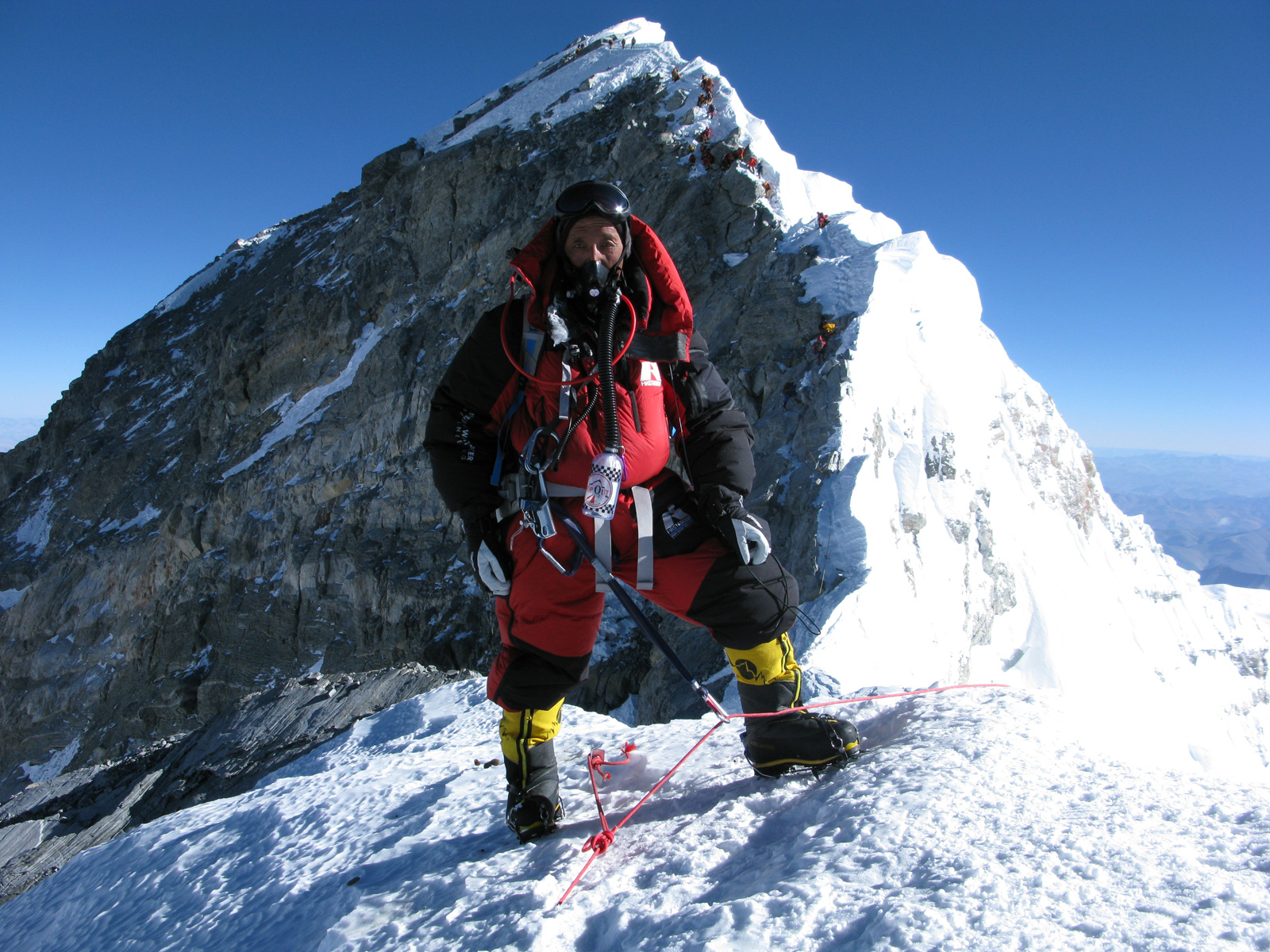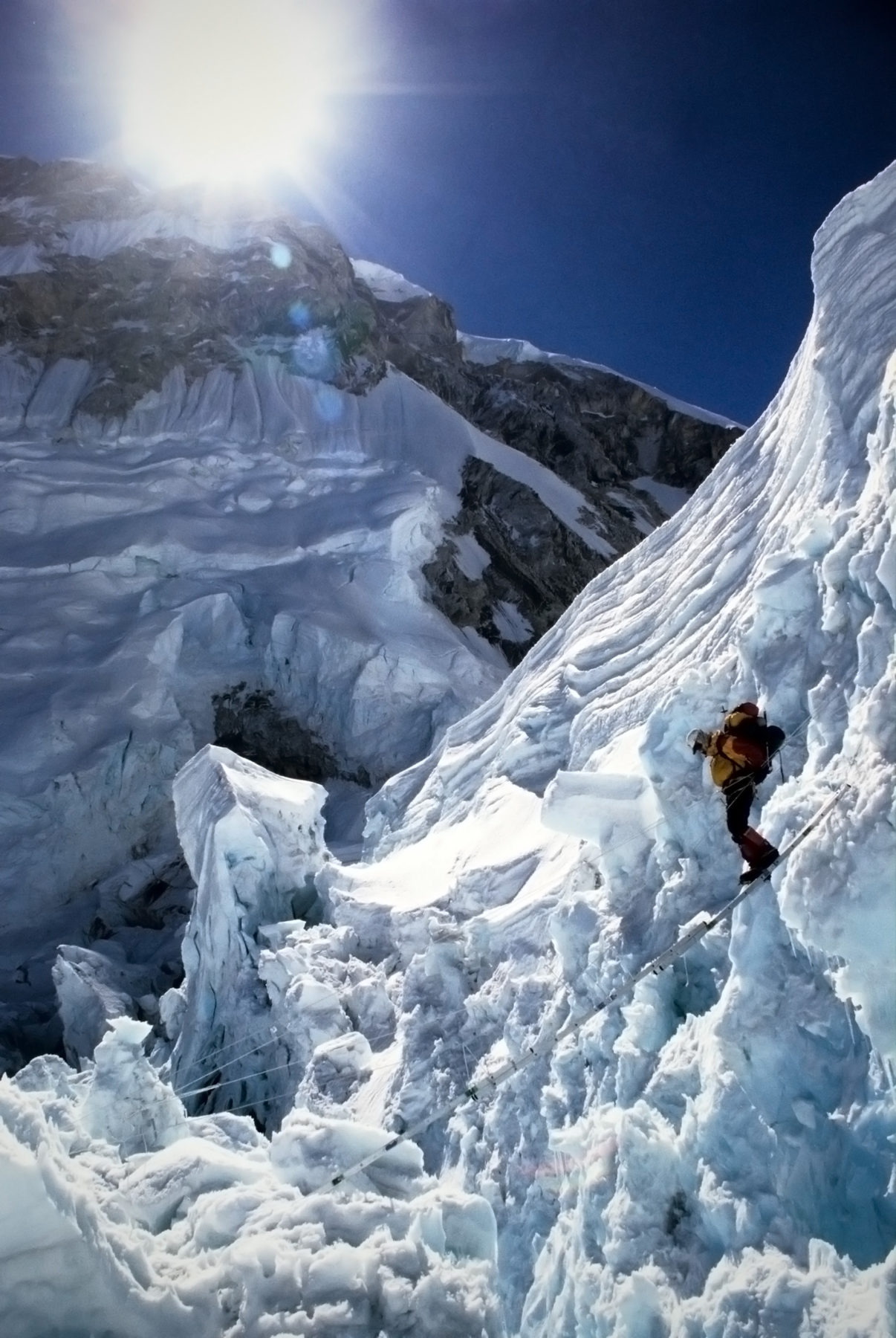On Top of the World: Apa Sherpa
Nicknamed ‘Super Sherpa’, Apa currently holds the world record for the highest number of successful summits of Mount Everest, or Sagarmatha to the Nepalese. Although he has summited 21 times, he still speaks of his first ascent in 1990 with reverence.
He made it to the top along with fellow first-timers Peter Hillary, Rob Hall and Gary Ball — three highly regarded New Zealand climbers — with Peter’s link to his father Edmund’s historic ascent making the experience that much more significant. There is a sense that the joy and excitement of finally reaching the summit is impossible to reduce to words: Apa remembers, “it was like I was on the heavens.” He recalls the sense of achievement he felt, having been thinking and talking about this goal for so long.
Apa began his climbing career at age twelve after his father passed away. Having grown up in the rural village of Thame with minimal education, Apa ventured into the mountains as a means of supporting his family. Indeed, despite the dangers inherent in climbing peaks that are over 8000 metres high, into the ‘death zone’ of high altitude oxygen deprivation and hypothermia, many Sherpas are forced down the same route. To allow Western climbers to focus on the business of climbing, it is the Sherpas’ responsibility to lay out ropes and ladders, to shuttle supplies up to the high altitude camps, and to guide their clients towards the Himalayas’ highest summits.

Providing this support for expeditions through some of the world’s most taxing alpine terrain is risky work. On Everest, Sherpas walk through the Khumbu Icefall — one of the most perilous parts of the Southern Route — not once or twice as Western climbers do, but hundreds of times throughout the course of their working life. In 2014, in one of the worst disasters in the mountain’s history, sixteen Sherpa guides tragically lost their lives in an avalanche on the Icefall. However, Apa estimates that each year four or five Sherpas perish in the same way — it is simply part of life on the mountain.
Despite this danger, the omnipresent challenge of extreme altitude is the primary concern when it comes to preparing for an ascent. Apa is pleased to see Western climbers and their guides investing more time and energy training on smaller peaks such as Aconcagua in Argentina and Denali in Alaska to better prepare for the rigors of the Himalayas. Previously, climbers would pay a hefty fee to travel to the Himalayas and attempt to climb with little to no experience, which led to unfortunate, avoidable deaths. While Western climbers will always have the desire to be standing ‘on top of the world’, they now appear to better understand the environment, conditions, and the pure challenge of an 8000 metre peak.
This is no doubt due to the firm approach of Sherpas like Apa, who insist their clients heed their advice and turn back when necessary. Apa recounts the disappointment of a failed attempt on Everest in 1989 with Hall and Ball, where they reached the 8000-metre mark but were forced to turn back due to illness. They all went back down, and gave it another shot the following year. This experience exemplifies Apa’s approach to climbing: “the mountain’s not going anywhere,” he says, and “life is more important.” With this in mind, Apa retired from climbing after his twenty-first summit in 2011, and emigrated to the USA.

A lot had changed in the intervening decades, particularly in terms of technology. When he first started climbing Everest, Apa would at times go months without contact with his family. Even the postal service was lacking: he recalls sending a letter home from the Tibetan side of the mountain which took a full month to arrive, getting there just before he did. Fast forward to 2010, and Apa was able to call his family, by then in Salt Lake City, to say, “Hey, I’m on the top!”
Although he emphasizes that “Everest is never easy,” over the years Apa became more familiar and confident with the mountain, coming to “know almost all the rocks.” As a result, it is a place that he feels a strong connection to, and responsibility for. Seeing with his own eyes the impact of climate change on the topography of the mountain — which now shows many more of those rocks than it did when it was blanketed in snow 20 years ago — Apa has resolved to do all he can to raise awareness about the mountain’s environmental state.
From 1998 to 2011, Apa worked with various expeditions to clean up Everest, determined to bring global awareness to the growing issue of hazardous waste polluting the pristine mountain. As of 2011, with the help of Team Eco Everest and other organizations, Apa had removed from the 8000-metre zone more than 17,000 kilograms of garbage, oxygen cylinders, and human waste left by previous expeditions.

Apa believes the next great adventure activity in the Himalayas is paragliding from 8000-metre mountains, an incredible physical and mental challenge. There have been several successful bids already, including a French athlete paragliding from the Everest summit to Camp Two at 6400 metres. Two Nepali paragliders also set off from the Everest summit and landed at the Syangboche airstrip, a distance of roughly 30 kilometres as the crow flies. All this is not to say that the adventure has gone out of the ascent, especially during the winter when not just Everest but “all the mountains are a challenge.” Recent daring ascents of Everest by Sherpa Ang Rita, and of Gasherbrum II by a global team demonstrate the ongoing potential of the region for those with the right skills and experience.
Despite settling down in recent years, Apa’s adventuring is not over yet either. In 2012, he led the first end-to-end trek of the Great Himalaya Trail, a 1700 kilometre route that spans the length of the Nepalese Himalayas. Considered to be one of the most grueling hikes in the world, the trek stretched from the Nepalese east to the Tibetan border. Over the 99 days of the trek, the team aimed to show the world that there are many beautiful places to see in the Himalayas other than Everest, in the hopes of bringing some well-deserved prosperity to the wider region.
Further expeditions to the Everest region in 2015 and 2016 have continued to promote the region, with funds raised going to the Apa Sherpa Foundation, its goals intensified following the 2015 earthquake. While his summiting days may be behind him, Apa’s ambitions continue to remain as lofty as the mighty peaks he once conquered.

